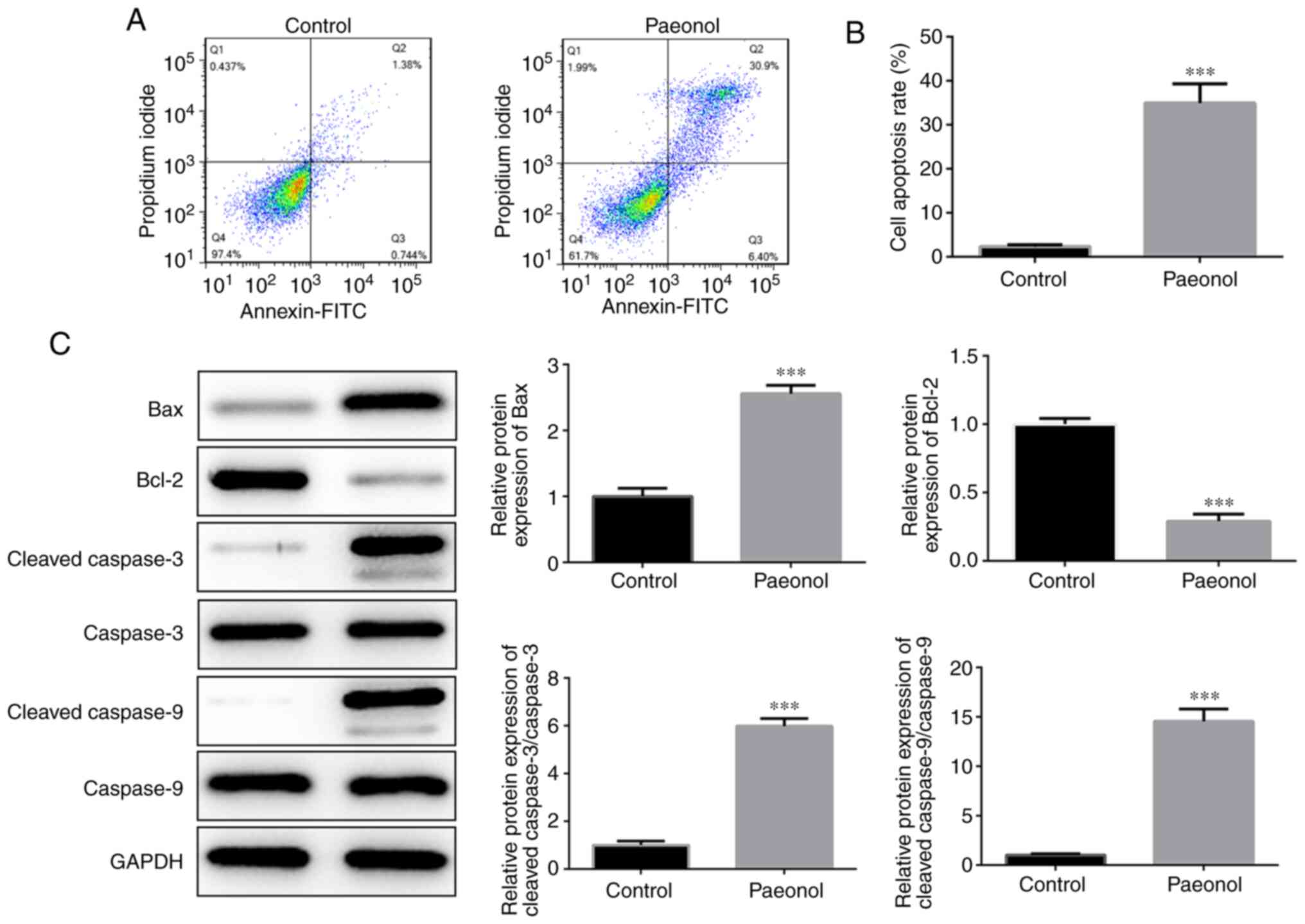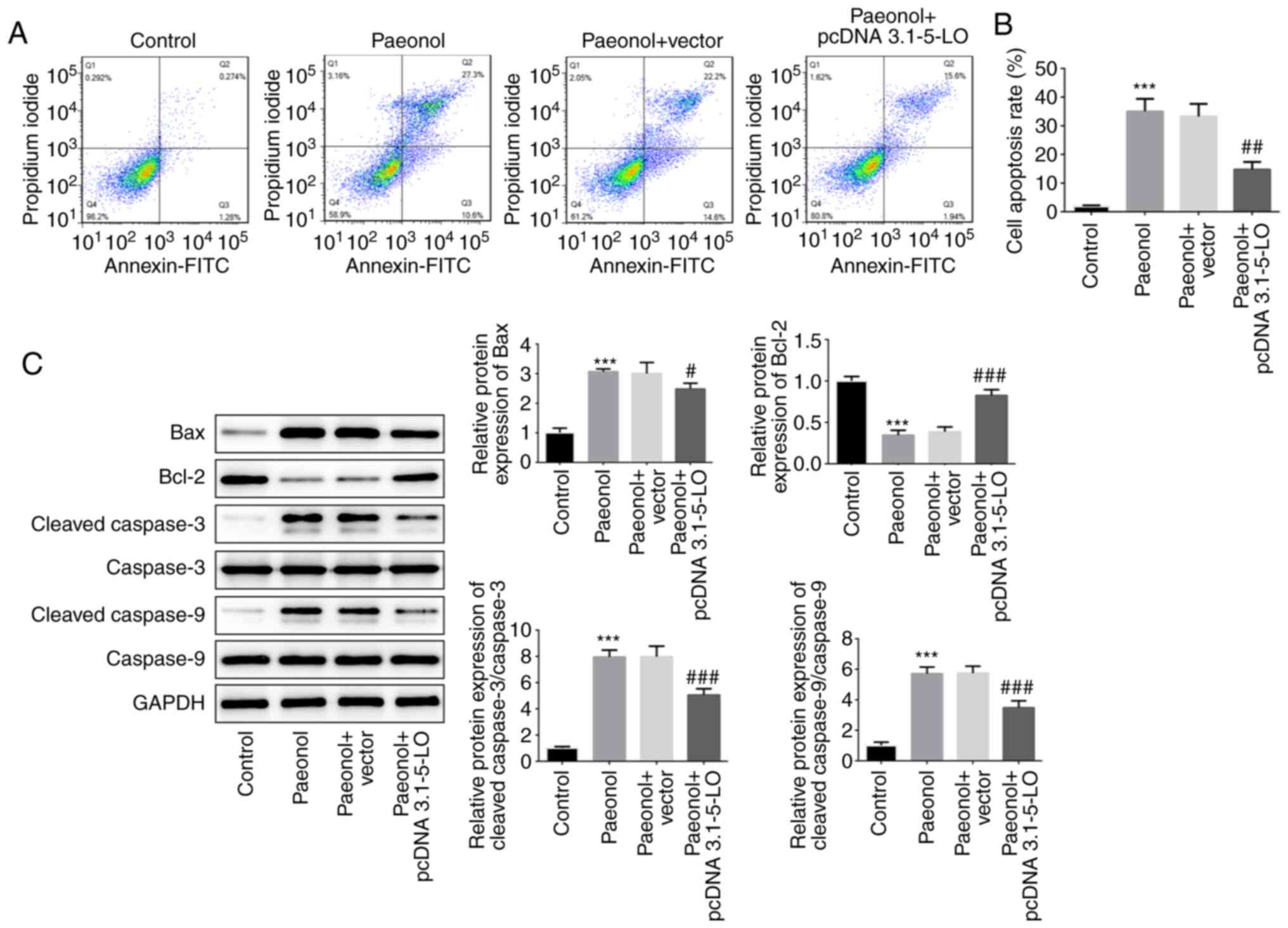|
1
|
Wei J and Wang Y, Shi K and Wang Y:
Identification of core prognosis-related candidate genes in
cervical cancer via integrated bioinformatical analysis. Biomed Res
Int. 2020:89592102020. View Article : Google Scholar : PubMed/NCBI
|
|
2
|
Wei H, Wang XW, Chen KM, Ling SR and Yi
CJ: Analysis of gene mutation associated with tyrosine kinase
inhibitor sensitivity of epidermal growth factor receptor in
cervical cancer patients. Eur Rev Med Pharmacol Sci. 22:6280–6287.
2018.PubMed/NCBI
|
|
3
|
Cheng CS, Chen JX, Tang J, Geng YW, Zheng
L, Lv LL, Chen LY and Chen Z: Paeonol inhibits pancreatic cancer
cell migration and invasion through the inhibition of TGF-β1/smad
signaling and epithelial-mesenchymal-transition. Cancer Manag Res.
12:641–651. 2020. View Article : Google Scholar : PubMed/NCBI
|
|
4
|
Mohamed MZ, Morsy MA, Mohamed HH and Hafez
HM: Paeonol protects against testicular ischaemia-reperfusion
injury in rats through inhibition of oxidative stress and
inflammation. Andrologia. 52:e135992020. View Article : Google Scholar : PubMed/NCBI
|
|
5
|
Gao L, Wang Z, Lu D, Huang J, Liu J and
Hong L: Paeonol induces cytoprotective autophagy via blocking the
Akt/mTOR pathway in ovarian cancer cells. Cell Death Dis.
10:6092019. View Article : Google Scholar : PubMed/NCBI
|
|
6
|
Zhou J, Liu Q, Qian R, Liu S, Hu W and Liu
Z: Paeonol antagonizes oncogenesis of osteosarcoma by inhibiting
the function of TLR4/MAPK/NF-κB pathway. Acta histochemica.
122:1514552020. View Article : Google Scholar : PubMed/NCBI
|
|
7
|
Fu J, Yu L, Luo J, Huo R and Zhu B:
Paeonol induces the apoptosis of the SGC7901 gastric cancer cell
line by downregulating ERBB2 and inhibiting the NF-κB signaling
pathway. Int J Mol Med. 42:1473–1483. 2018.PubMed/NCBI
|
|
8
|
Saahene RO, Wang J, Wang ML, Agbo E and
Pang D: The antitumor mechanism of paeonol on CXCL4/CXCR3-B signals
in breast cancer through induction of tumor cell apoptosis. Cancer
Biother Radiopharm. 33:233–240. 2018. View Article : Google Scholar : PubMed/NCBI
|
|
9
|
Moore GY and Pidgeon GP: Cross-talk
between cancer cells and the tumour microenvironment: The role of
the 5-Lipoxygenase pathway. Int J Mol Sci. 18:2362017. View Article : Google Scholar
|
|
10
|
Mahboubi-Rabbani M and Zarghi A:
Lipoxygenase inhibitors as cancer chemopreventives: Discovery,
recent developments, and future perspectives. Curr Med Chem. 2019.
View Article : Google Scholar : PubMed/NCBI
|
|
11
|
Monga J, Subramani D, Bharathan A and
Ghosh J: Pharmacological and genetic targeting of 5-lipoxygenase
interrupts c-Myc oncogenic signaling and kills
enzalutamide-resistant prostate cancer cells via apoptosis. Sci
Rep. 10:66492020. View Article : Google Scholar : PubMed/NCBI
|
|
12
|
Costa H, Touma J, Davoudi B, Benard M,
Sauer T, Geisler J, Vetvik K, Rahbar A and Soderberg-Naucler C:
Human cytomegalovirus infection is correlated with enhanced
cyclooxygenase-2 and 5-lipoxygenase protein expression in breast
cancer. J Cancer Res Clin Oncol. 145:2083–2095. 2019. View Article : Google Scholar : PubMed/NCBI
|
|
13
|
Go JH, Wei JD, Park JI, Ahn KS and Kim JH:
Wogonin suppresses the LPSenhanced invasiveness of MDAMB231 breast
cancer cells by inhibiting the 5LO/BLT2 cascade. Int J Mol Med.
42:1899–1908, 20180. PubMed/NCBI
|
|
14
|
Livak KJ and Schmittgen TD: Analysis of
relative gene expression data using real-time quantitative PCR and
the 2(-Delta Delta C(T)) method. Methods. 25:402–408. 2001.
View Article : Google Scholar : PubMed/NCBI
|
|
15
|
Lee YY, Choi CH, Sung CO, Do IG, Huh S,
Song T, Kim MK, Kim HJ, Kim TJ, Lee JW, et al: Prognostic value of
pre-treatment circulating monocyte count in patients with cervical
cancer: comparison with SCC-Ag level. Gynecol Oncol. 124:92–97.
2012. View Article : Google Scholar : PubMed/NCBI
|
|
16
|
Aishanjiang A, Rouzi N, Jiao Z, Wang L,
Wusainahong K, Wumanjiang N, Musha M and Niyazi M: MicroRNA-9
enhances invasion and migration of cervical carcinomas by directly
targeting FOXO1. Eur Rev Med Pharmacol Sci. 22:2253–2260.
2018.PubMed/NCBI
|
|
17
|
Banno K, Iida M, Yanokura M, Kisu I, Iwata
T, Tominaga E, Tanaka K and Aoki D: MicroRNA in cervical cancer:
OncomiRs and tumor suppressor miRs in diagnosis and treatment.
ScientificWorldJournal. 2014:1780752014. View Article : Google Scholar : PubMed/NCBI
|
|
18
|
Meng X, Chu Y, Pan Y, Han L, Meng Z and
Wang X: Preoperative neoadjuvant chemotherapy combined with radical
surgery in cervical cancer. J BUON. 25:125–131. 2020.PubMed/NCBI
|
|
19
|
Al-Taher AY, Morsy MA, Rifaai RA, Zenhom
NM and Abdel-Gaber SA: Paeonol attenuates methotrexate-induced
cardiac toxicity in rats by inhibiting oxidative stress and
suppressing TLR4-Induced NF-κB inflammatory pathway. Mediators
Inflamm. 2020:86410262020. View Article : Google Scholar : PubMed/NCBI
|
|
20
|
Jin X, Wang J, Xia ZM, Shang CH, Chao QL,
Liu YR, Fan HY, Chen DQ, Qiu F and Zhao F: Anti-inflammatory and
anti-oxidative activities of paeonol and its metabolites through
blocking MAPK/ERK/p38 signaling pathway. Inflammation. 39:434–446.
2016. View Article : Google Scholar : PubMed/NCBI
|
|
21
|
Hafez HM, Morsy MA, Mohamed MZ and Zenhom
NM: Mechanisms underlying gastroprotective effect of paeonol
against indomethacin-induced ulcer in rats. Hum Exp Toxicol.
38:510–518. 2019. View Article : Google Scholar : PubMed/NCBI
|
|
22
|
Li H, Song F, Duan LR, Sheng JJ, Xie YH,
Yang Q, Chen Y, Dong QQ, Zhang BL and Wang SW: Paeonol and
danshensu combination attenuates apoptosis in myocardial infarcted
rats by inhibiting oxidative stress: Roles of Nrf2/HO-1 and
PI3K/Akt pathway. Sci Rep. 6:236932016. View Article : Google Scholar : PubMed/NCBI
|
|
23
|
Cheng CS, Chen JX, Tang J, Geng YW, Zheng
L, Lv LL, Chen LY and Chen Z: Paeonol inhibits pancreatic cancer
cell migration and invasion through the inhibition of
TGF-beta1/smad signaling and epithelial-mesenchymal-transition.
Cancer Manag Res. 12:641–651. 2020. View Article : Google Scholar : PubMed/NCBI
|
|
24
|
Liu X, Xu Q, Mei L, Lei H, Wen Q, Miao J,
Huang H, Chen D, Du S, Zhang S, et al: Paeonol attenuates acute
lung injury by inhibiting HMGB1 in lipopolysaccharide-induced shock
rats. Int Immunopharmacol. 61:169–177. 2018. View Article : Google Scholar : PubMed/NCBI
|
|
25
|
Mei L, He M, Zhang C, Miao J, Wen Q, Liu
X, Xu Q, Ye S, Ye P, Huang H, et al: Paeonol attenuates
inflammation by targeting HMGB1 through upregulating miR-339-5p.
Sci Rep. 9:193702019. View Article : Google Scholar : PubMed/NCBI
|
|
26
|
Lyu ZK, Li CL, Jin Y, Liu YZ, Zhang X,
Zhang F, Ning LN, Liang ES, Ma M, Gao W, et al: Paeonol exerts
potential activities to inhibit the growth, migration and invasion
of human gastric cancer BGC823 cells via downregulating MMP2 and
MMP9. Mol Med Rep. 16:7513–7519. 2017. View Article : Google Scholar : PubMed/NCBI
|
|
27
|
Bai CY, Zhang JY, Shi TW, Bai YQ, Wu BL,
Du ZP, Wu ZY, Xu XE, Wang SH, Wu JY, et al: Association between
5-lipoxygenase expression, and malignant behaviors and poor
prognosis in esophageal squamous cell carcinoma. Oncol Lett.
15:9353–9360. 2018.PubMed/NCBI
|
|
28
|
Kummer NT, Nowicki TS, Azzi JP, Reyes I,
Iacob C, Xie S, Swati I, Darzynkiewicz Z, Gotlinger KH, Suslina N,
et al: Arachidonate 5 lipoxygenase expression in papillary thyroid
carcinoma promotes invasion via MMP-9 induction. J Cell Biochem.
113:1998–2008. 2012. View Article : Google Scholar : PubMed/NCBI
|














